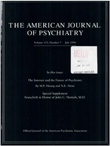Mental illness and creative activity in female writers
Abstract
OBJECTIVE: This study addressed three questions. Are female writers more likely to suffer from mental illness than members of a matched comparison group? If so, does a familial basis exist for their psychopathology and creativity? What factors predict overall creativity in women? METHOD: Questionnaire and interview data were obtained on 59 female writers and 59 members of a matched comparison group. These data were used to assess overall creativity and to identify psychiatric disorders in subjects and their first-degree relatives. RESULTS: Female writers were more likely than members of the comparison group to suffer not only from mood disorders but from drug abuse, panic attacks, general anxiety, and eating disorders as well. The rates of multiple mental disorders were also higher among writers. Although there was evidence for the familial transmission of psychopathology, physical or sexual abuse during childhood also loomed as a potential contributor to later psychological difficulties. Creativity also appeared to run in families. The cumulative psychopathology scores of subjects, their reported exposure to sexual or physical abuse during childhood, mental difficulties in their mothers, and the combined creativity scores of their parents represented significant predictors of their overall creativity. CONCLUSIONS: The high rates of certain emotional disorders in female writers suggested a direct relationship between creativity and psychopathology. But the relationship was not necessarily a simple one. As the results of the predictive analysis indicated, familial and environmental factors also appeared to play an important role.
Access content
To read the fulltext, please use one of the options below to sign in or purchase access.- Personal login
- Institutional Login
- Sign in via OpenAthens
- Register for access
-
Please login/register if you wish to pair your device and check access availability.
Not a subscriber?
PsychiatryOnline subscription options offer access to the DSM-5 library, books, journals, CME, and patient resources. This all-in-one virtual library provides psychiatrists and mental health professionals with key resources for diagnosis, treatment, research, and professional development.
Need more help? PsychiatryOnline Customer Service may be reached by emailing [email protected] or by calling 800-368-5777 (in the U.S.) or 703-907-7322 (outside the U.S.).



